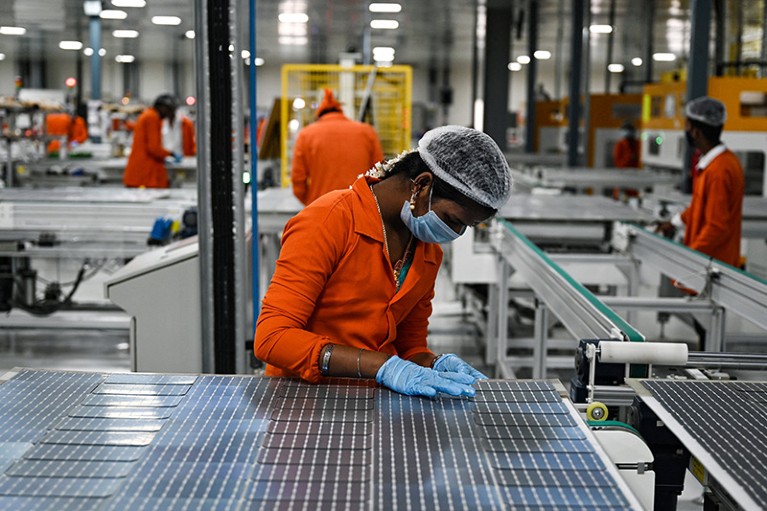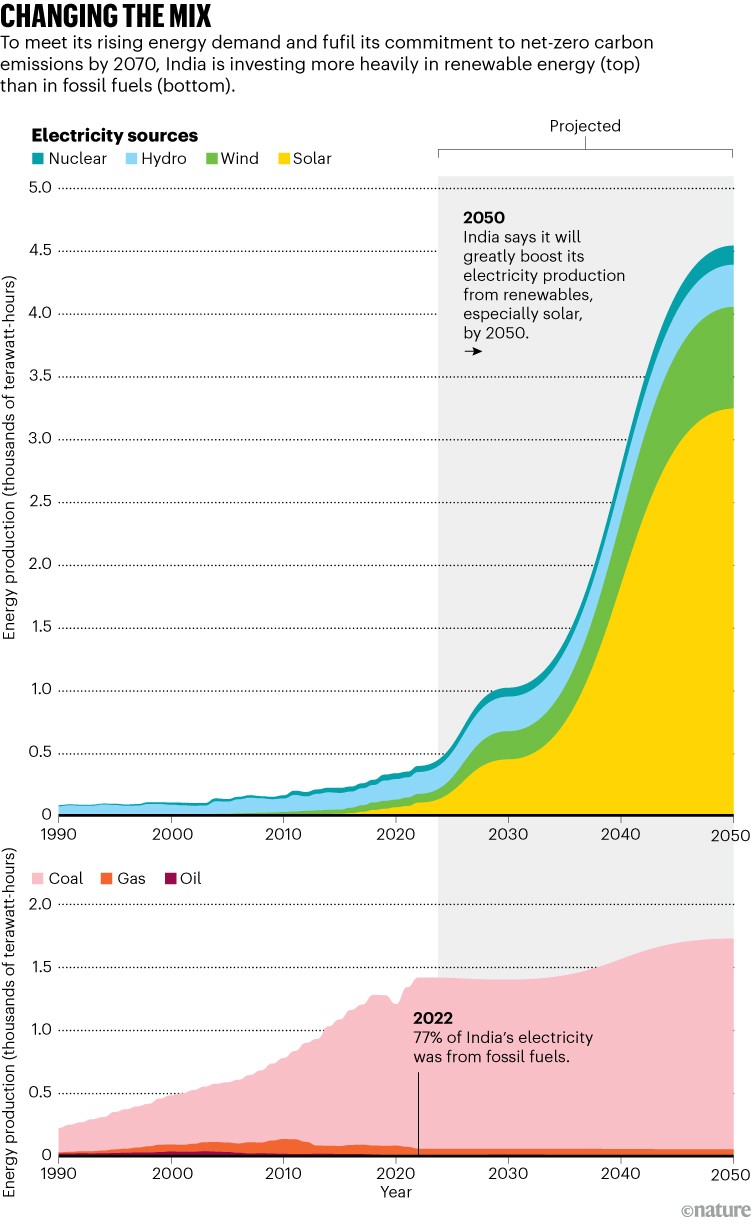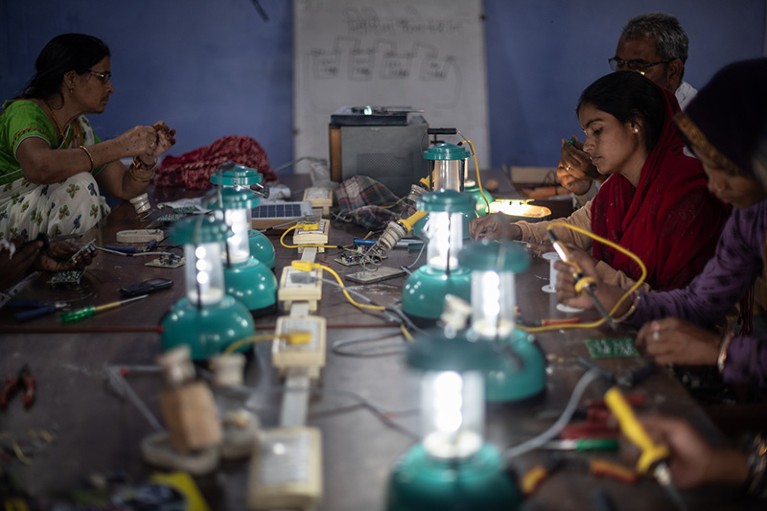
Workers at the Vikram Solar manufacturing plant at Oragadam in Tamil Nadu, part of India’s push to use solar power.Credit: Arun Sankar/AFP via Getty
When it comes to renewable energy, India is lucky to have an abundance of natural resources. It is the seventh-largest nation on Earth, occupying around 2% of the planet’s land mass, and has a mainland coastline that stretches for 7,500 kilometres. Most regions experience between 250 and 300 sunny days a year and there are vast areas with strong winds. The government has a keen interest in increasing the manufacture of renewables technology and is providing the support it needs. It spent nearly US$2.4 billion on manufacturing solar-photovoltaic products in 2021, for example.
India’s meteoric economic growth over the past two decades has been fuelled largely by the combustion of coal and oil. Much of its electricity supply still comes from coal-fired power plants, which currently provide 48% of India’s energy supply. And the government continues to open coal mines to meet the rising energy demand from the economy.
But in 2021, the government announced plans to generate 50% of its electricity from renewables by 2030 and to cut its emissions to net zero by 2070 (see ‘Changing the mix’). It would be an important change for a nation that is the third-highest global emitter of carbon dioxide — albeit one of the lowest emitters per capita. Even so, the independent scientific organization Climate Action Tracker considers these targets to be ‘critically insufficient’ and in line with 4 °C of global warming by 2100.

Sources: Our world in data, US Energy Information Administration
Renewable sources currently make up 42% of India’s installed energy-generation capacity, which makes the 50% target by 2030 look easy and perhaps not ambitious enough. But India faces many challenges on its journey to decarbonization.
The country’s continued economic growth means that electricity demand is currently increasing at a staggering rate: 7% per year between 2010 and 2019, and 10% between 2021 and 2022.
“How do we do it and at the same time elevate the incomes of people achieving economic growth and transitioning from fossil fuels?” asks Charith Konda, energy finance analyst at the Institute for Energy Economics and Financial Analysis, a global think-tank on environmental and economic issues based in Hyderabad, India.
The Indian government says it will do it by installing 500 gigawatts of renewable-energy capacity by 2030. The nation currently has around 180 gigawatts of renewable energy capacity installed, comprising 67 gigawatts of solar power, 43 gigawatts of wind power, 10 gigawatts of biomass and cogeneration of electricity and heat, and the rest is a mix of hydro power and waste-to-energy.
Support for solar
The low-hanging fruit in India’s renewable-energy space is solar photovoltaic. “We have abundant solar energy available in the country. We have plenty of land,” says Jai Prakash, deputy director-general of the National Institute of Solar Energy, a research and development organization based in Gurugram, India. “Solar energy is cost-effective in India and the price of solar generation is actually lower than conventional fossil-fuels-based energy,” he adds.
The government has long planned to take advantage of India’s solar resources. In 2010, it launched the National Solar Mission, with a view to making the nation a global leader in solar energy and installing 100 gigawatts of grid-connected solar power capacity by 2022. It hadn’t quite hit that target by November 2022, but the government has invested heavily in schemes to get there.
This investment has yielded the world’s second-largest solar park — 57 square kilometres of photovoltaic panels in the inhospitable Thar Desert in the northwestern state of Rajasthan. The park has the capacity to generate 2.2 gigawatts of energy.
The investment goes further. The Solar Park Scheme provides financial support — up to 30% of the project costs — and other incentives, such as helping with infrastructure and grid connectivity to encourage the building of solar parks of 500 megawatts or larger.
Another initiative is designed to increase the number of grid-connected rooftop solar installations, with the goal of installing 40 gigawatts of capacity by 2026. These incentives target both individual home-owners and electricity distributors.
There is also a scheme for farmers in which the state and the national government will subsidize up to 90% of the cost of installing solar-powered water pumps. “The idea is to reduce the diesel generator–base pump system so we can reduce oil consumption throughout the country,” Prakash says. “The farmer can also generate some additional electricity and sell it to the grid.”

Villagers assemble solar lamps as part of India’s Barefoot solar project.Credit: Rebecca Conway/Getty
Most of the solar photovoltaic panels used in India are currently imported from China, Konda says. But given the geopolitical tensions between the two nations, the Indian government is keen to end that reliance by making its own solar panels. India can currently make solar cells and modules with a cumulative capacity of around 38 gigawatts a year, which is expected to rise to 110 gigawatts by 2026. Smaller solar projects — including the rooftop initiative — that receive government support are required to use panels made in India.
But there are challenges ahead, Prakash says. India does not yet have the capability to produce advanced solar technologies, and it faces the same supply-chain issues for raw materials as many other nations do. It also faces a skills shortage. “Manufacturing has recently started up” and we need a lot of skilled workers, he says. There are now increasing numbers of courses that provide training in solar-cell manufacturing techniques, he adds.
Wind of change
The manufacture of wind turbines is also being given a push in India, with the intention of servicing the growing wind-power industry by using domestic, rather than imported, turbines. Some states, such as Tamil Nadu, are already doing well in this regard, thanks to their existing engineering and manufacturing capacity, says Francis Jayasurya, the Chennai-based India director of the Global Wind Energy Council, an international trade association for the wind-power industry. “Tamil Nadu is known as the Detroit of south India,” Jayasurya says, referring to the US city noted for its car manufacturing. “The transition from the automobile industry to the wind sector, on the technical side, was very easy.”
This success in turbine manufacturing is helping to boost wind power by providing almost a one-stop shop for setting up wind farms, in which turbine manufacturers procure the land and arrange the transmission infrastructure. “All the investors have to do is come there and ask for the turbine and it’s plug-and-play,” Jayasurya says.
Around 10% of India’s electricity is currently supplied by wind power, most of which is generated onshore, mainly in the western states, particularly Gujarat, but also in Tamil Nadu in the southeast. There is interest in developing offshore wind power, but that requires a solution to the challenge of laying extensive undersea transmission cables. “The interest in offshore renewable is clear, but it doesn’t give confidence to the investors,” Jayasurya says.
One problem for renewable-energy capacity, not just in India but globally, is that the Sun sets and the wind dies down. Previously, “most of the plans were without storage”, Prakash says. But now the focus is on round-the-clock power from projects that combine solar and wind power with energy storage.
Storage solutions
India’s storage sector is therefore experiencing a boom. When the India Energy Storage Alliance, a trade body that represents the energy-storage sector, was established in 2012, only five international companies were interested in bringing advanced energy-storage solutions to India, says its president, Rahul Walawalker. Now the organization has more than 160 members. India has long been a strong market for energy storage, he says. The country’s notoriously fickle grid stability has led many consumers to store energy to protect them from blackouts.
Conventional lead–acid batteries have provided a buffer against peak price surges in homes and offices. But the rise of renewable energy has shifted the focus to larger and more-advanced energy-storage technologies, such as lithium-ion batteries, flow batteries, mechanical storage and forms of gravity storage, such as pumped hydro power.
In August 2023, India’s Ministry of Power released a report, the National Framework for Promoting Energy Storage Systems, emphasizing the importance of energy storage to India achieving its goal of getting 50% of its energy from renewable sources by 2030. The report says this will need 336 gigawatt-hours of storage by 2030. Most of it will probably come from either pumped hydro power or lithium-ion batteries, Walawalker says.
India currently has 41 megawatt-hours of battery energy-storage capacity and 4.7 gigawatt-hours of pumped hydro storage, of which only 3.3 gigawatts is operational.
The government is trying to be ‘technology agnostic’ when it comes to supporting energy storage, Walawalker says, but the two leading technologies are very different and serve different needs. Pumped hydro storage projects typically have a lifespan of about 25–30 years, but it can take almost that long to get projects approved and built because of the environmental and social challenges they face. Batteries — particularly the most widely used lithium-ion batteries — can be installed quickly but provide only short-term storage, typically measured in days or even hours.
Consumers are taking matters into their own hands. “We are seeing that many customer segments, such as hotels, resorts and data centres, have started looking at storage seriously, because now renewables plus storage has started to become cheaper than buying power as a commercial customer from utilities,” Walawalker says.
There is lots of good news about renewable energy in India, but the country is still a long way from reducing its consumption of coal and the climate-warming emissions that creates. It is not as simple as replacing existing coal-fired power with renewables, Konda says. “We have to meet the additional new demand coming up. There’s huge growth and transitioning at the same time, so it’s quite challenging.”


 India’s year in science
India’s year in science
 Where science meets Indian economics: in five charts
Where science meets Indian economics: in five charts
 We need to talk about water
We need to talk about water
 The climate disaster strikes: what the data say
The climate disaster strikes: what the data say
 I predict solar storms
I predict solar storms
 The fight against antimicrobial resistance
The fight against antimicrobial resistance
 How high-impact papers from Indian researchers are shaping science
How high-impact papers from Indian researchers are shaping science
 India struggles to turn science into societal benefits
India struggles to turn science into societal benefits
 Big ideas: India’s drive to stem the brain drain
Big ideas: India’s drive to stem the brain drain
 I study depression in the lab and advocate for mental health in academia
I study depression in the lab and advocate for mental health in academia






